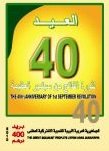Stamp: Revolution Through 40 Years (Libya 2010)
Revolution Through 40 Years (Libya 2010)
23 August (Libya ) within release The 40th Anniversary of the Al-Fateh Revolution goes into circulation Stamp Revolution Through 40 Years face value 40 Libyan dirham
| Stamp Revolution Through 40 Years in catalogues | |
|---|---|
| Michel: | Mi: LY 2981 |
Stamp is vertical format.
Also in the issue The 40th Anniversary of the Al-Fateh Revolution:
- Stamp - Revolution Through 40 Years face value 40;
- Stamp - Revolution Through 40 Years face value 40;
- Stamp - Revolution Through 40 Years face value 40;
- Stamp - Revolution Through 40 Years face value 40;
- Stamp - Revolution Through 40 Years face value 40;
- Stamp - Revolution Through 40 Years face value 40;
- Stamp - Revolution Through 40 Years face value 40;
- Stamp - Revolution Through 40 Years face value 40;
- Stamp - Revolution Through 40 Years face value 40;
- Stamp - Revolution Through 40 Years face value 40;
- Stamp - Revolution Through 40 Years face value 40;
- Stamp - Revolution Through 40 Years face value 40;
- Stamp - Revolution Through 40 Years face value 40;
- Stamp - Revolution Through 40 Years face value 40;
- Stamp - Revolution Through 40 Years face value 40;
- Stamp - Revolution Through 40 Years face value 40;
- Stamp - Revolution Through 40 Years face value 40;
- Stamp - Revolution Through 40 Years face value 40;
- Mini Sheet - Revolution Through 40 Years face value 40*400;
- Stamp - Revolution Through 40 Years face value 40;
- Stamp - Revolution Through 40 Years face value 40;
- Stamp - Revolution Through 40 Years face value 40;
- Stamp - Revolution Through 40 Years face value 40;
- Stamp - Revolution Through 40 Years face value 40;
- Stamp - Revolution Through 40 Years face value 40;
- Stamp - Revolution Through 40 Years face value 40;
- Stamp - Revolution Through 40 Years face value 40;
- Stamp - Revolution Through 40 Years face value 40;
- Stamp - Revolution Through 40 Years face value 40;
- Stamp - Revolution Through 40 Years face value 40;
- Stamp - Revolution Through 40 Years face value 40;
- Stamp - Revolution Through 40 Years face value 40;
- Stamp - Revolution Through 40 Years face value 40;
- Stamp - Revolution Through 40 Years face value 40;
- Stamp - Revolution Through 40 Years face value 40;
- Stamp - Revolution Through 40 Years face value 40;
- Stamp - Revolution Through 40 Years face value 40;
- Stamp - Revolution Through 40 Years face value 40;
- Stamp - Revolution Through 40 Years face value 40;
- Stamp - Revolution Through 40 Years face value 40;
- Stamp - Revolution Through 40 Years face value 40;
Stamp Revolution Through 40 Years it reflects the thematic directions:
A number is a mathematical object used to count, measure, and label. The most basic examples are the natural numbers 1, 2, 3, 4, and so forth. Numbers can be represented in language with number words. More universally, individual numbers can be represented by symbols, called numerals; for example, "5" is a numeral that represents the number five. As only a relatively small number of symbols can be memorized, basic numerals are commonly organized in a numeral system, which is an organized way to represent any number. The most common numeral system is the Hindu–Arabic numeral system, which allows for the representation of any non-negative integer using a combination of ten fundamental numeric symbols, called digits. In addition to their use in counting and measuring, numerals are often used for labels (as with telephone numbers), for ordering (as with serial numbers), and for codes (as with ISBNs). In common usage, a numeral is not clearly distinguished from the number that it represents.
A symbol is a mark, sign, or word that indicates, signifies, or is understood as representing an idea, object, or relationship. Symbols allow people to go beyond what is known or seen by creating linkages between otherwise very different concepts and experiences. All communication (and data processing) is achieved through the use of symbols. Symbols take the form of words, sounds, gestures, ideas, or visual images and are used to convey other ideas and beliefs. For example, a red octagon is a common symbol for "STOP"; on maps, blue lines often represent rivers; and a red rose often symbolizes love and compassion. Numerals are symbols for numbers; letters of an alphabet may be symbols for certain phonemes; and personal names are symbols representing individuals.


